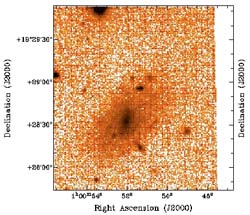 Recent observations performed by Olivier Hernandez, astrophysicist at UdeM and member of the CRAQ, and by Laurent Chemin from the Observatoire de Paris, showed the first evidence of a stellar bar in slow rotation inside a spiral galaxy. The observed galaxy, UGC 628, is quite particular: its mass is dominated by dark matter and it emits less light than normal galaxies. Recent observations performed by Olivier Hernandez, astrophysicist at UdeM and member of the CRAQ, and by Laurent Chemin from the Observatoire de Paris, showed the first evidence of a stellar bar in slow rotation inside a spiral galaxy. The observed galaxy, UGC 628, is quite particular: its mass is dominated by dark matter and it emits less light than normal galaxies.
For more than a decade, observations shows that when a spiral galaxies has a bar (a feature in the centre composed of stars and from which the spiral arms emerge), this bar is in rapid rotation. However, these measurements concerned almost exclusively bright galaxies which have having a large stellar core and a small amount of gas, such as the lenticular S0 type . Those spiral galaxies, whose morphology is close to elliptic, are called “early-type” for historical reason. The galaxy UGC 628, located 230 millions of light years away, is a “late-type galaxy”, its shape is more spiral-like: it has a lot of gas and almost no central core.
This special galaxy was observed using Fabry-Perot optical interferometry technique on the intrument FaNTOmM (http://www.astro.umontreal.ca/fantomm/), built by the Laboratoire d'Astrophysique Expérimentale of the CRAQ. Thanks to this instrument, temporarily installed on the 3.6m Canada-France-Hawaii telescope, and a method developed by Olivier Hernandez, it was determined that UGC 628 hosts a slow bar, rotating at a speed of one revolution per 550 millions years. This rotation speed is the smallest ever observed for a stellar bar in a galaxy. For comparison purpose, our own Galaxy, the Milk Way, has a bar that rotates at the speed of 1 turn per 250 millions years (twice as fast as that in UGC 628)
One of the preferred theory to explain this phenomena is the presence of a large Dark Matter component in the galaxy UGC 628, which contributes to slow down the bar rotation. Although this measurement is at the moment an isolated case, it suggests a correlation between angular velocity of stellar bars and the morphological type of the host galaxies: the rotation speed decreases from early-type (more elliptical) to late-type (more spherical). This discovery is one of the first observations that confirm the results of the numerous numerical simulations predicting the evolution of barred galaxies. It therefore provides some further support to the general theory of the LCDM cosmology (Standard Cold Dark Matter).
The article was accepted for publication on April 23rd 2009 in the scientific journal Astronomy and Astrophysics. A pre-print version can be found here http://xxx.lanl.gov/abs/0904.3442
Informations:
Dr. Olivier Hernandez, relation avec les médias
CRAQ – Université de Montréal
Tel: 514-343-6111 ext 4681
Cel: 514-582-9802
olivier@astro.umontreal.ca |

 Recent observations performed by Olivier Hernandez, astrophysicist at UdeM and member of the CRAQ, and by Laurent Chemin from the Observatoire de Paris, showed the first evidence of a stellar bar in slow rotation inside a spiral galaxy. The observed galaxy, UGC 628, is quite particular: its mass is dominated by dark matter and it emits less light than normal galaxies.
Recent observations performed by Olivier Hernandez, astrophysicist at UdeM and member of the CRAQ, and by Laurent Chemin from the Observatoire de Paris, showed the first evidence of a stellar bar in slow rotation inside a spiral galaxy. The observed galaxy, UGC 628, is quite particular: its mass is dominated by dark matter and it emits less light than normal galaxies.